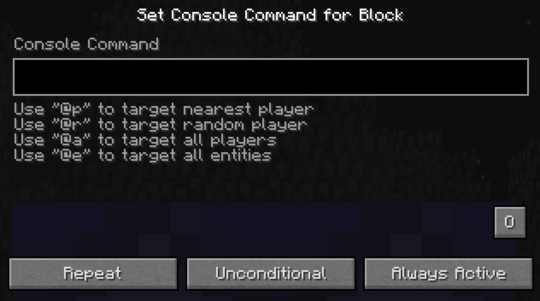124
23
Your task is to create the shortest infinite loop!
The point of this challenge is to create an infinite loop producing no output, unlike its possible duplicate. The reason to this is because the code might be shorter if no output is given.
Rules
- Each submission must be a full program.
- You must create the shortest infinite loop.
- Even if your program runs out of memory eventually, it is still accepted as long as it is running the whole time from the start to when it runs out of memory. Also when it runs out of memory, it should still not print anything to STDERR.
- The program must take no input (however, reading from a file is allowed), and should not print anything to STDOUT. Output to a file is also forbidden.
- The program must not write anything to STDERR.
- Feel free to use a language (or language version) even if it's newer than this challenge. -Note that there must be an interpreter so the submission can be tested. It is allowed (and even encouraged) to write this interpreter yourself for a previously unimplemented language. :D
- Submissions are scored in bytes, in an appropriate (pre-existing) encoding, usually (but not necessarily) UTF-8. Some languages, like Folders, are a bit tricky to score - if in doubt, please ask on Meta.
- This is not about finding the language with the shortest infinite loop program. This is about finding the shortest infinite loop program in every language. Therefore, I will not accept an answer.
- If your language of choice is a trivial variant of another (potentially more popular) language which already has an answer (think BASIC or SQL dialects, Unix shells or trivial Brainf**k-derivatives like Alphuck), consider adding a note to the existing answer that the same or a very similar solution is also the shortest in the other language.
- There should be a website such as Wikipedia, Esolangs, or GitHub for the language. For example, if the language is CJam, then one could link to the site in the header like
#[CJam](http://sourceforge.net/p/cjam/wiki/Home/), X bytes. - Standard loopholes are not allowed.
(I have taken some of these rules from Martin Büttner's "Hello World" challenge)
Please feel free to post in the comments to tell me how this challenge could be improved.
Catalogue
This is a Stack Snippet which generates both an alphabetical catalogue of the used languages, and an overall leaderboard. To make sure your answer shows up, please start it with this Markdown header:
# Language name, X bytes
Obviously replacing Language name and X bytes with the proper items. If you want to link to the languages' website, use this template, as posted above:
#[Language name](http://link.to/the/language), X bytes
Now, finally, here's the snippet: (Try pressing "Full page" for a better view.)
var QUESTION_ID=59347;var ANSWER_FILTER="!t)IWYnsLAZle2tQ3KqrVveCRJfxcRLe";var COMMENT_FILTER="!)Q2B_A2kjfAiU78X(md6BoYk";var OVERRIDE_USER=41805;var answers=[],answers_hash,answer_ids,answer_page=1,more_answers=true,comment_page;function answersUrl(index){return"//api.stackexchange.com/2.2/questions/"+QUESTION_ID+"/answers?page="+index+"&pagesize=100&order=desc&sort=creation&site=codegolf&filter="+ANSWER_FILTER}function commentUrl(index,answers){return"//api.stackexchange.com/2.2/answers/"+answers.join(';')+"/comments?page="+index+"&pagesize=100&order=desc&sort=creation&site=codegolf&filter="+COMMENT_FILTER}function getAnswers(){jQuery.ajax({url:answersUrl(answer_page++),method:"get",dataType:"jsonp",crossDomain:true,success:function(data){answers.push.apply(answers,data.items);answers_hash=[];answer_ids=[];data.items.forEach(function(a){a.comments=[];var id=+a.share_link.match(/\d+/);answer_ids.push(id);answers_hash[id]=a});if(!data.has_more)more_answers=false;comment_page=1;getComments()}})}function getComments(){jQuery.ajax({url:commentUrl(comment_page++,answer_ids),method:"get",dataType:"jsonp",crossDomain:true,success:function(data){data.items.forEach(function(c){if(c.owner.user_id===OVERRIDE_USER)answers_hash[c.post_id].comments.push(c)});if(data.has_more)getComments();else if(more_answers)getAnswers();else process()}})}getAnswers();var SCORE_REG=/<h\d>\s*([^\n,<]*(?:<(?:[^\n>]*>[^\n<]*<\/[^\n>]*>)[^\n,<]*)*),.*?(\d+)(?=[^\n\d<>]*(?:<(?:s>[^\n<>]*<\/s>|[^\n<>]+>)[^\n\d<>]*)*<\/h\d>)/;var OVERRIDE_REG=/^Override\s*header:\s*/i;function getAuthorName(a){return a.owner.display_name}function process(){var valid=[];answers.forEach(function(a){var body=a.body;a.comments.forEach(function(c){if(OVERRIDE_REG.test(c.body))body='<h1>'+c.body.replace(OVERRIDE_REG,'')+'</h1>'});var match=body.match(SCORE_REG);if(match)valid.push({user:getAuthorName(a),size:+match[2],language:match[1],link:a.share_link,});else console.log(body)});valid.sort(function(a,b){var aB=a.size,bB=b.size;return aB-bB});var languages={};var place=1;var lastSize=null;var lastPlace=1;valid.forEach(function(a){if(a.size!=lastSize)lastPlace=place;lastSize=a.size;++place;var answer=jQuery("#answer-template").html();answer=answer.replace("{{PLACE}}",lastPlace+".").replace("{{NAME}}",a.user).replace("{{LANGUAGE}}",a.language).replace("{{SIZE}}",a.size).replace("{{LINK}}",a.link);answer=jQuery(answer);jQuery("#answers").append(answer);var lang=a.language;lang=jQuery('<a>'+lang+'</a>').text();languages[lang]=languages[lang]||{lang:a.language,lang_raw:lang,user:a.user,size:a.size,link:a.link}});var langs=[];for(var lang in languages)if(languages.hasOwnProperty(lang))langs.push(languages[lang]);langs.sort(function(a,b){if(a.lang_raw.toLowerCase()>b.lang_raw.toLowerCase())return 1;if(a.lang_raw.toLowerCase()<b.lang_raw.toLowerCase())return-1;return 0});for(var i=0;i<langs.length;++i){var language=jQuery("#language-template").html();var lang=langs[i];language=language.replace("{{LANGUAGE}}",lang.lang).replace("{{NAME}}",lang.user).replace("{{SIZE}}",lang.size).replace("{{LINK}}",lang.link);language=jQuery(language);jQuery("#languages").append(language)}}body{text-align:left!important}#answer-list{padding:10px;width:500px;float:left}#language-list{padding:10px;padding-right:40px;width:500px;float:left}table thead{font-weight:700}table td{padding:5px}<script src="https://ajax.googleapis.com/ajax/libs/jquery/2.1.1/jquery.min.js"></script> <link rel="stylesheet" type="text/css" href="//cdn.sstatic.net/codegolf/all.css?v=83c949450c8b"> <div id="language-list"> <h2>Shortest Solution by Language</h2> <table class="language-list"> <thead> <tr><td>Language</td><td>User</td><td>Score</td></tr> </thead> <tbody id="languages"> </tbody> </table> </div> <div id="answer-list"> <h2>Leaderboard</h2> <table class="answer-list"> <thead> <tr><td></td><td>Author</td><td>Language</td><td>Size</td></tr> </thead> <tbody id="answers"> </tbody> </table> </div> <table style="display: none"> <tbody id="answer-template"> <tr><td>{{PLACE}}</td><td>{{NAME}}</td><td>{{LANGUAGE}}</td><td>{{SIZE}}</td><td><a href="{{LINK}}">Link</a></td></tr> </tbody> </table> <table style="display: none"> <tbody id="language-template"> <tr><td>{{LANGUAGE}}</td><td>{{NAME}}</td><td>{{SIZE}}</td><td><a href="{{LINK}}">Link</a></td></tr> </tbody> </table>




41I've got to start posting programs with a negative byte count to beat all these empty files! – CJ Dennis – 2015-10-03T04:32:30.037
3This challenge is interesting because it brings out lots of 0 byte languages (some of which are NOT esolangs). FWIW, most declarative languages have an implicit infinite loop because declarative languages don't have loops in their syntax (they assume they're running in an infinite loop). Ladder diagrams are perhaps among the oldest such languages. Then you have the Instruction Language (IL), a sort of assembly for PLCs that also assume an infinite loop. ILs, like assembly are different between manufacturers – slebetman – 2015-10-05T09:36:50.273
Are programs that read and execute their own source code allowed, or does file I/O break the "must take no input" rule? – ThisSuitIsBlackNot – 2015-10-06T13:05:04.253
1@ThisSuitIsBlackNot Yes, file input is allowed. – user41805 – 2015-10-06T16:47:01.750
Can you print
"", an empty string? – OldBunny2800 – 2016-03-07T23:39:09.760Most C compilers create a temporary file to avoid torturing the memory when resolving preprocessor directives. Does it make this answer non-competing because it throws the compiler itself in an infinite loop using a recursive #inclusion?
– user8397947 – 2016-05-29T15:57:32.987Btw, here's a general note: Open the links on the leaderboard on a new tab/window. – user8397947 – 2016-05-29T15:59:35.323
@OldBunny2800 No, you can't – user41805 – 2016-11-12T07:45:03.903
@KritixiLithos Do you mean, no trailing newline, right? Because just printing an empty string without a trailing newline is no output at all. – Erik the Outgolfer – 2016-11-12T10:19:18.537
@EriktheGolfer As weird as it sounds, not even an empty string
""should be outputted. – user41805 – 2016-11-12T10:22:42.600@KritixiLithos I mean, without the quotes and trailing newlines. Of course
"can't be in the output. – Erik the Outgolfer – 2016-11-12T10:24:19.820@EriktheGolfer I also mean without the quotes and without trailing newlines. – user41805 – 2016-11-12T10:25:15.953
@KritixiLithos Oh... gosh. So, let's say that you can't use
print(end='')in Python 3, for example. I think this is really weird, but I'll adhere to the rule. – Erik the Outgolfer – 2016-11-12T10:29:15.903